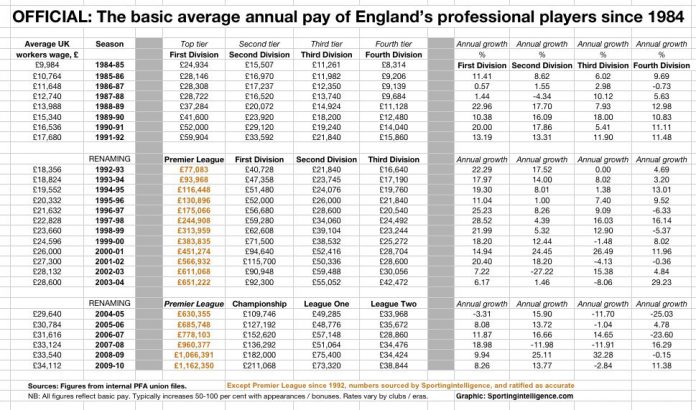Football wages are a ridiculously easy target – whether it’s the high wages paid by Chelsea and then Manchester City, the astronomical wage bills of Barcelona and Real Madrid fueled by unequal TV deals or the retirement homes that front as football clubs in Eastern Europe and the Middle East, football wages have steadily increased in the last 20-25 years.
But by how much? And is the growth spread evenly across all tiers of the game or concentrated at the highest level? You may already know the answer to that question, but even then the numbers below are eye-opening.
The data is taken from sportingintelligence.com (who have used their own research + an official PFA document detailing basic wages for the last 25 years) – here are some highlights:
The text below is taken from sportingintelligence.com – see source articles here and here:
- In 1984-85, top division players in England earned a basic average of £480 per week (£25,000 a year), which was more than double what the average worker earned, and which was three times as much as players earned in the Fourth Division. Today the difference is 30 times as much.
- In 1984-85, according to the PFA’s data, the average basic wage in the First Division – as the top division was then called – was £24,934 a year, or about two and a half times the average working man’s salary. With bonuses, it would have been around £36,000, perhaps more.
- In 2009-10, the average basic Premier League wage was £1.16m and the average take-home pay was £1.76m.
- In the Premier League, double-digit annual growth has been the norm in most years of the competition’s history. The biggest single leap was the 28.52 per cent year-on-year growth between 1996-97 and 1997-98. This was due to a new TV deal kicking in.
- TV cash has fueled players’ pay rises in the Premier League era. The first Premier League deal was over five years (1992-97), then next over four years (1997-2001), and the deals have been three years each since then (2001-04, 2004-07, 2007-10 and 2010-13 currently).
- The average annual basic salary in the Championship in 2009-10 was £211,068, in League One it was £73,320 and in League Two it was £38,844.
- Top division footballers now earn 46 times as much as they did in 1984-85
- Those in the Championship earn only 14 times as much as their counterparts.
- In League One the figure is six and a half times as much. In League Two the figure is 4.6 times as much.
- The average working man earns about three times as much.
Image from sportingintelligence.com.
Note: The numbers represent basic pay; wages typically increase by 50 to 100 per cent with appearance money and bonuses.
On the other hand, football ticket prices have increased by almost as much as 30 times in certain cases (looking at cheapest tickets / season tickets at Manchester United and London clubs).
And if you look at the commercial revenues generated by US sports, it’s evident that football, a more global sport, has still some way to go before it can reach it’s financial peak. So expect the TV deals, player wages and ticket prices to keep rising.
Add Sportslens to your Google News Feed!








